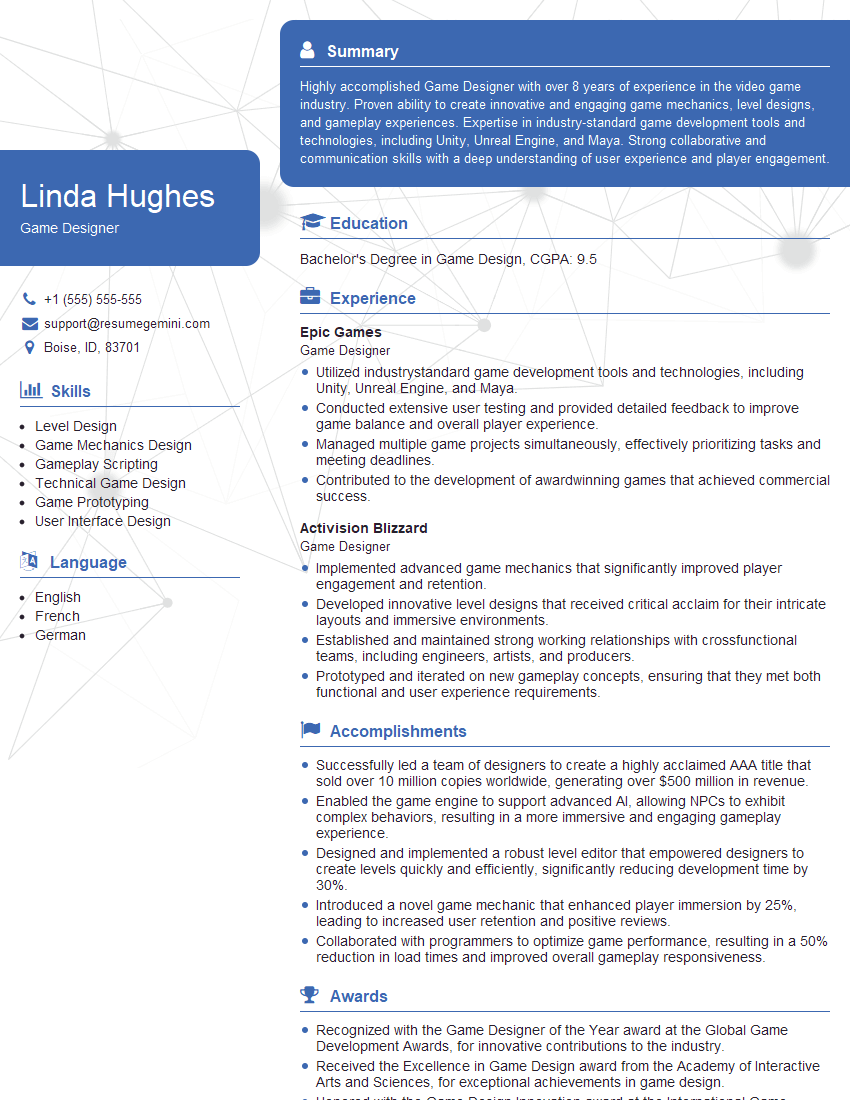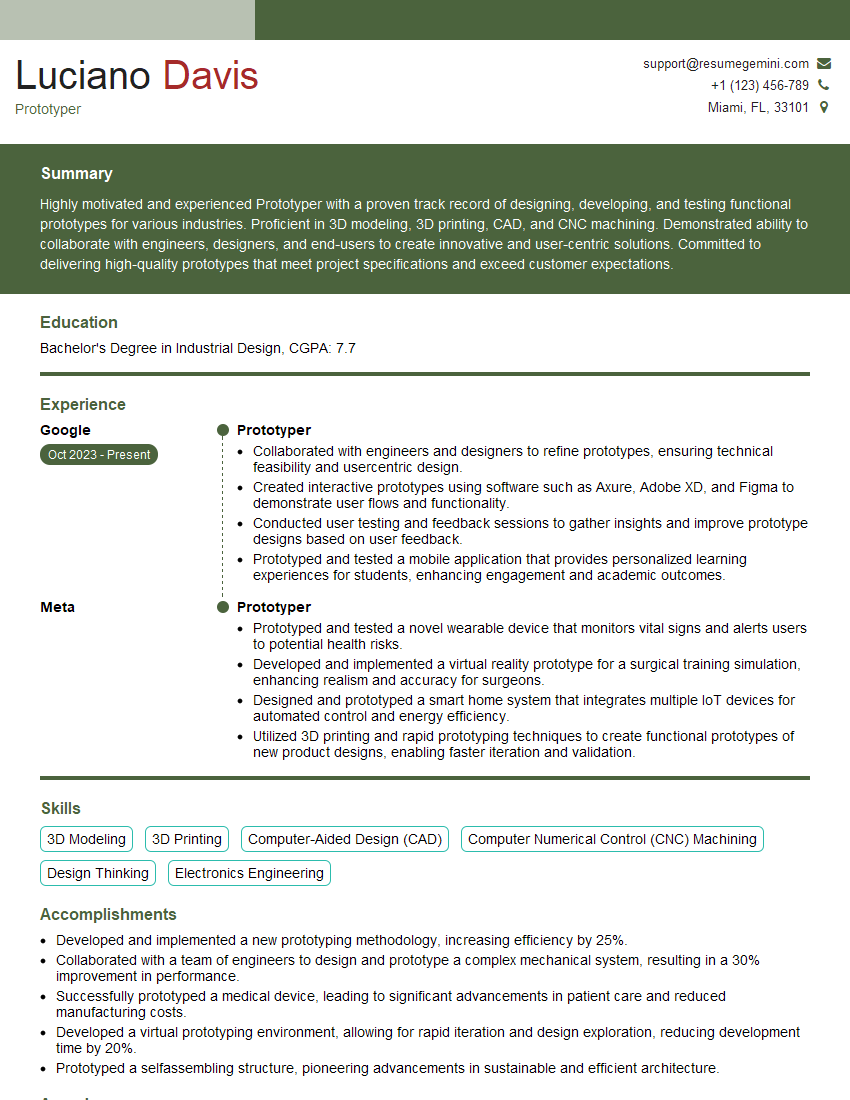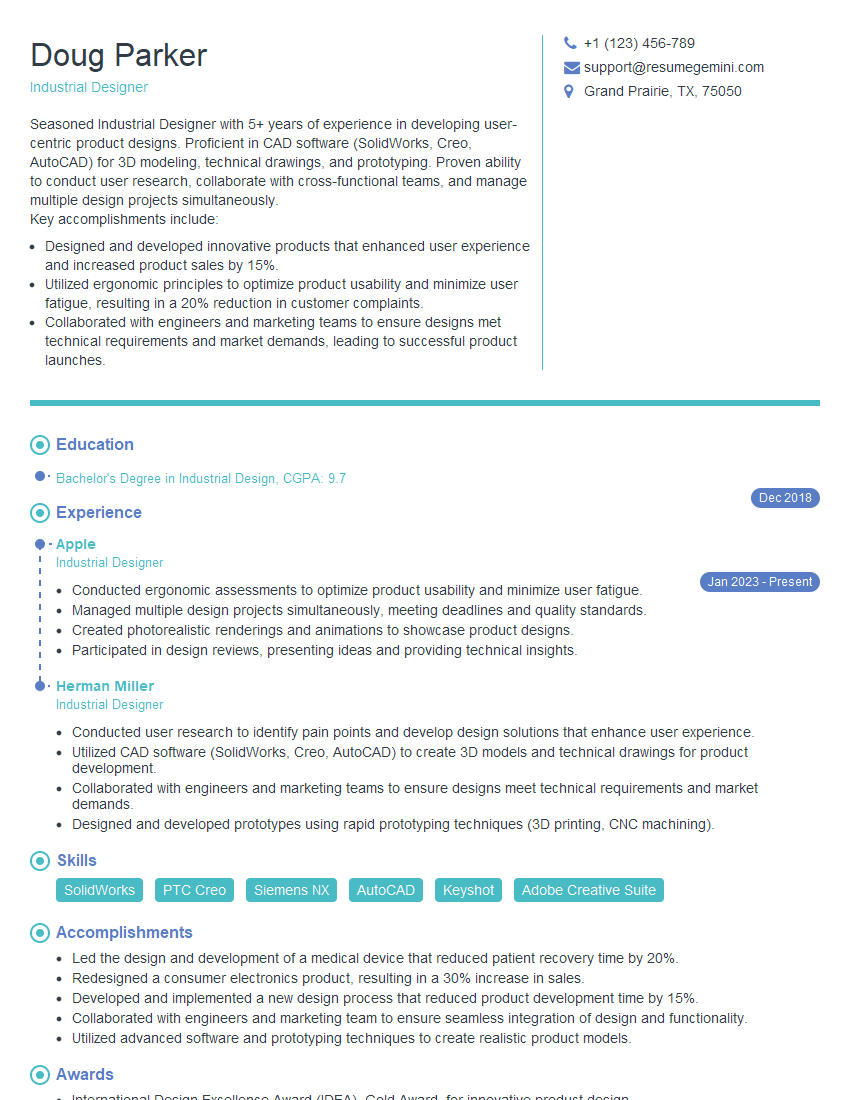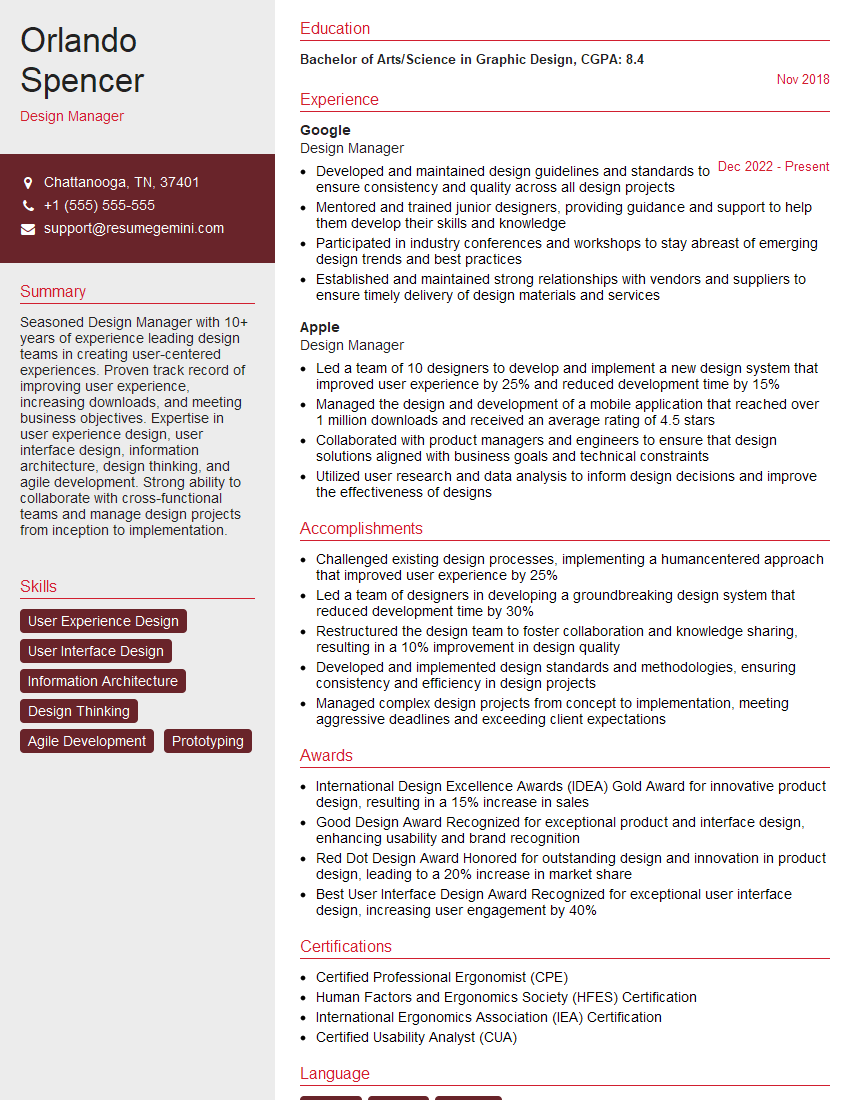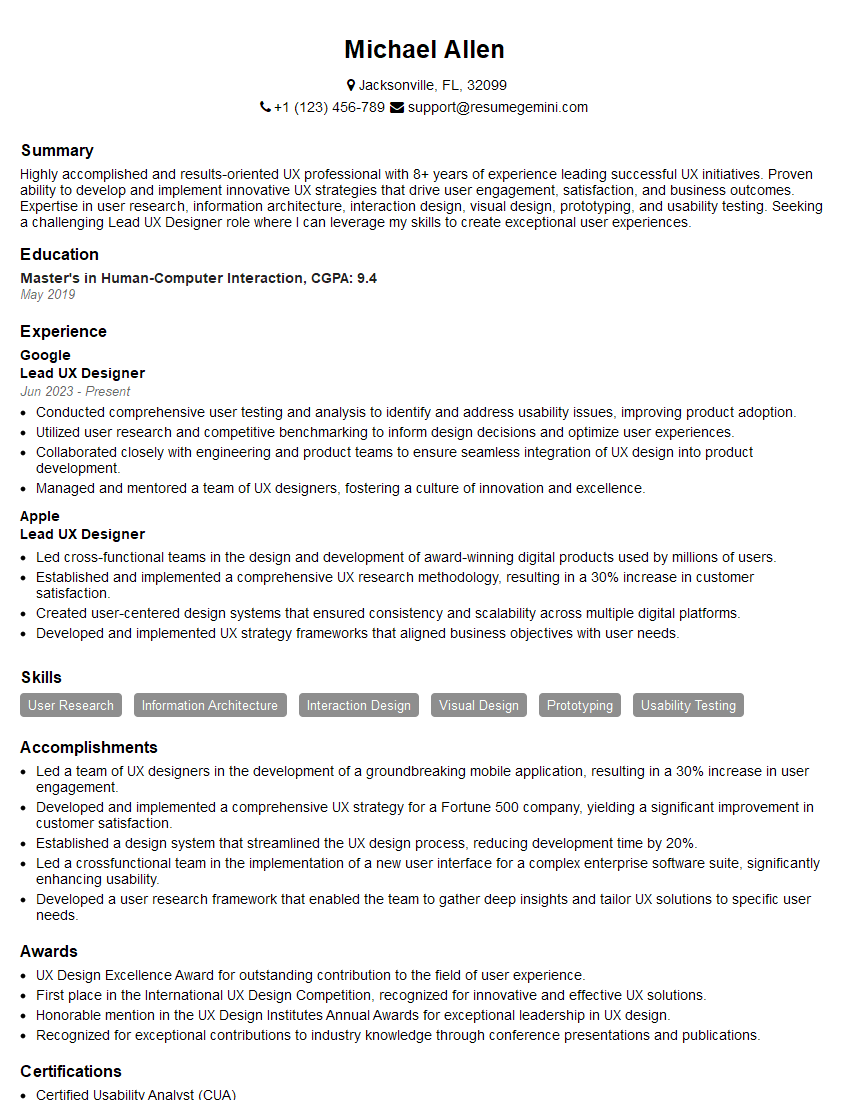Every successful interview starts with knowing what to expect. In this blog, we’ll take you through the top Design Sketching interview questions, breaking them down with expert tips to help you deliver impactful answers. Step into your next interview fully prepared and ready to succeed.
Questions Asked in Design Sketching Interview
Q 1. Explain your design sketching process.
My design sketching process is iterative and highly contextual, adapting to the specific project needs. It generally follows these steps:
- Understanding the Problem: Before even picking up a pencil, I thoroughly understand the design challenge, the target audience, and the project goals. This often involves user research and competitor analysis.
- Initial Ideation: I begin with quick, loose sketches, focusing on generating a large quantity of diverse ideas. These are often thumbnail sketches, focusing on layout and key elements.
- Refinement and Exploration: I select promising concepts from the initial sketches and refine them, adding details and exploring variations. This stage involves more detailed drawings, potentially incorporating annotations to explain design choices.
- Testing and Iteration: I frequently seek feedback on my sketches from colleagues and stakeholders. This feedback informs further refinements and iterations, leading to a stronger design.
- Final Sketch: The final sketch is a polished representation of the chosen design, incorporating all the feedback and revisions. It may also include key specifications like dimensions or material notes.
For example, while designing a mobile app, I might start with thumbnail sketches showing different layout options. Then, I’d refine a chosen layout, sketching detailed screens with interactive elements. I’d then test those sketches with potential users and make adjustments based on their feedback.
Q 2. Describe your preferred sketching tools and materials.
My preferred tools and materials are chosen for their versatility and ability to support rapid ideation. I primarily use:
- Paper: I prefer a good quality sketchpad with smooth, slightly textured paper. Different paper weights can be useful for different stages of sketching.
- Pencils: A range of pencils (2H, HB, 2B, 4B) allows for varying line weights and shading, capturing different levels of detail. I also use fine-liner pens for crisp lines and details.
- Markers: Markers offer quick ways to add color and emphasis. I might use a limited palette to quickly block out areas of color or explore different mood boards.
- Eraser: A good quality kneaded eraser is indispensable for making corrections and adjustments without damaging the paper.
While I appreciate digital tools, there’s something about the tactile nature of pencil on paper that facilitates spontaneous creativity. Digital tools are valuable in later stages, however.
Q 3. How do you use sketching to explore different design solutions?
Sketching is invaluable for exploring different design solutions because it allows for rapid iteration and low-risk experimentation. Instead of investing time in high-fidelity digital mockups, I use sketches to:
- Explore alternative layouts: Quickly sketch multiple layouts to compare different approaches and identify the most effective arrangement of elements.
- Test different interaction models: Sketch different ways users might interact with a design, noting potential usability issues and areas for improvement.
- Experiment with visual styles: Explore different visual styles, color palettes, and typography through sketches to determine the best aesthetic for the project.
- Communicate ideas quickly: Sketching is a fast and efficient way to visualize ideas and share them with others for feedback and discussion.
For instance, when designing a website, I might sketch several variations on the homepage layout – one focused on imagery, another on text, and another on a more balanced approach. This allows me to quickly compare and contrast options.
Q 4. How do you translate low-fidelity sketches into high-fidelity designs?
The transition from low-fidelity sketches to high-fidelity designs is a gradual process. I typically use the following steps:
- Scan or Photograph: I start by creating a digital version of my final sketch, either by scanning it or taking a high-resolution photograph.
- Vectorization (Optional): Depending on the complexity, I may trace the sketch in a vector graphics editor (like Adobe Illustrator) to create clean lines and shapes.
- Digital Refinement: I then use design software (like Adobe XD or Figma) to refine the design, adding details, color, typography, and interactive elements. The sketch acts as a blueprint.
- Iteration and Testing: I continue to iterate on the digital design, testing and refining it based on feedback from users and stakeholders.
Imagine a sketched app icon: The sketch establishes the basic shape and elements. Then, in a digital design tool, I’d perfect the icon’s proportions, add gradients and shadows, and ensure that it scales correctly for various screen sizes.
Q 5. How do you handle feedback on your sketches?
Handling feedback on sketches is crucial for iterative design improvement. I approach feedback with an open mind, focusing on understanding the underlying concerns rather than taking criticism personally. My process includes:
- Active Listening: I carefully listen to the feedback, asking clarifying questions to ensure I understand the points being made.
- Note-Taking: I record all feedback, categorizing it by type (e.g., usability, aesthetics, functionality).
- Prioritization: I prioritize the feedback based on its impact on the overall design goals and user experience.
- Iteration and Revision: I revise my sketches based on the feedback, creating new iterations to address concerns and incorporate suggestions.
Constructive criticism is invaluable. A comment like, “The call-to-action button is too small,” provides actionable information that helps me improve the design.
Q 6. How do you incorporate user research insights into your sketches?
User research insights are fundamental to creating user-centered designs. I incorporate these insights into my sketches through several methods:
- Persona Development: I develop user personas based on research findings, visualizing the target users and their needs. This helps me tailor my sketches to their specific requirements.
- User Journey Mapping: I use user journey maps to visualize the steps a user takes when interacting with the design. This helps me identify potential pain points and areas for improvement in my sketches.
- Sketching User Flows: I sketch user flows to represent the sequence of actions a user takes, enabling me to assess navigation and discoverability issues early in the design process.
- Annotating Sketches: I annotate my sketches with user research findings, such as quotes from user interviews or insights from usability testing. This ensures the design decisions are driven by data.
For example, if user research shows users struggle to find a specific feature, I would reflect this in my sketches by highlighting that area and brainstorming solutions to improve its prominence.
Q 7. How do you communicate design ideas effectively through sketches?
Effective communication through sketches relies on clarity, conciseness, and appropriate level of detail. My strategies include:
- Clear Visual Hierarchy: I use line weight, shading, and color to highlight important elements and guide the viewer’s eye.
- Annotations and Labels: I use annotations to explain design choices, clarify functionality, and provide context.
- Consistent Style: I maintain a consistent visual style throughout the sketches to avoid confusion.
- Storytelling: I use sketches to tell a story about the user experience, demonstrating how users will interact with the design.
- Presentation: I present sketches clearly, organizing them logically and providing context through verbal explanations.
Think of a sketched website navigation menu: A clear visual hierarchy emphasizes the most important links, while annotations might explain the functionality of each item. This ensures the idea is easily understood.
Q 8. What are some common sketching techniques you use?
My sketching technique is multifaceted, adapting to the design problem at hand. I frequently use a combination of methods. For quick ideation, I employ low-fidelity sketching with simple shapes and minimal detail, focusing on capturing the core concept. This allows for rapid exploration of multiple options. For more detailed explorations, I transition to mid-fidelity sketching, adding more refined elements like text placeholders and basic UI components. Finally, for presentations or communicating complex interactions, high-fidelity sketching incorporating more detail and potentially some color can be helpful, though I aim to avoid making it so detailed it becomes indistinguishable from a digital mockup.
- Thumbnailing: Small, quick sketches to generate a large number of initial ideas.
- Storyboarding: A series of sketches to illustrate a user’s journey or interaction flow.
- Wireframing: Sketches that outline the structure and layout of a user interface.
I also experiment with different sketching tools, favoring pencils for their versatility and ease of erasing, but also employing pens for crisp lines when needed. The choice of tool often depends on the desired level of detail and the phase of the design process.
Q 9. How do you manage iterations and revisions in your sketching workflow?
Managing iterations and revisions in sketching is crucial. I typically start with a series of quick explorations on separate sheets of paper, using a numbering system or timestamp to track versions. This allows me to quickly compare and contrast different approaches. For significant changes, I’ll often create a new sketch instead of trying to heavily revise the original. This maintains clarity and prevents the original sketch from becoming cluttered and difficult to understand. I use annotations extensively to record notes, feedback, and decisions made during each iteration. These notes become invaluable during the design review process, ensuring everyone is on the same page. For collaborative projects, a digital scan or photo of each iteration can be shared with the team for feedback and review – enabling a clear record of the design evolution.
Q 10. How do you sketch user flows and wireframes?
Sketching user flows and wireframes is a core part of my process. For user flows, I use a combination of boxes and arrows to represent different screens or steps in a process. I label each box with a concise description of the screen’s purpose and use arrows to indicate the direction of user navigation. This allows me to visualize the entire user journey quickly and identify potential pain points or areas for improvement. For wireframes, I focus on the skeletal structure of the interface. I use rectangles to represent content areas, text placeholders for labels, and simple icons to denote interactive elements. The key is to avoid unnecessary detail and concentrate on the arrangement and functionality of the core components. The objective is to define the information architecture and the overall layout before moving to higher fidelity representations.
Q 11. How do you use sketching to solve complex design problems?
Sketching is invaluable for tackling complex design problems. It allows for rapid prototyping and experimentation without the constraints of digital tools. I often start by breaking down the problem into smaller, more manageable parts. Each part gets its own series of sketches, allowing me to explore different solutions individually. Then, I gradually integrate those solutions back together, testing and refining the interaction and flow. This iterative approach helps me visualize and identify potential issues early in the process, long before it becomes expensive to change course. It’s akin to building with LEGOs; you start with individual bricks and eventually build a complex structure by constantly testing and refining the design along the way.
Q 12. How do you balance speed and detail in your sketches?
Balancing speed and detail is about knowing when to prioritize each. In the early stages of design, speed is paramount. Quick, rough sketches are used to generate a wide range of ideas, allowing for exploration without getting bogged down in detail. As the design matures, I gradually increase the level of detail. This focused approach ensures that I don’t waste time adding detail to concepts that aren’t viable, while still providing sufficient refinement for the chosen design direction. Think of it as a sculptor chipping away at a block of marble—early stages are about removing unnecessary material quickly, then the focus shifts to fine-tuning the details.
Q 13. How do you ensure consistency in your sketching style?
Maintaining consistency in sketching style requires discipline and practice. I consistently use similar line weights, shading techniques, and visual language across sketches, making them easily understandable and recognizable. This can be aided by practicing a consistent approach to basic shapes and elements. I also utilize templates or guides to ensure alignment and consistency in layout. While a certain level of artistic freedom is beneficial, consistency is crucial to maintain a professional and unified look, enhancing the overall impact of the design.
Q 14. Describe a time when sketching helped you solve a design challenge.
Recently, I was tasked with designing a user interface for a complex financial application. The initial requirements were ambiguous and seemed to lead to an overly complex design. Using low-fidelity sketching, I explored various approaches, focusing on different information architectures. By rapidly sketching numerous variations, I discovered a simplified architecture that addressed the core needs of the users without unnecessary complexity. This simplified approach – inspired through the quick iterative process of sketching – ultimately led to a more intuitive and user-friendly application. It prevented us from creating a bloated interface and saved valuable development time and resources.
Q 15. How do you present your sketches to stakeholders?
Presenting sketches to stakeholders effectively requires a thoughtful approach. I don’t just show them a pile of drawings; I curate the presentation to tell a story and facilitate discussion. This usually involves a clear introduction outlining the design goals and the rationale behind the sketches. Then, I present the sketches in a logical sequence, highlighting key features and iterations. I might start with low-fidelity sketches showing initial concepts, progressing to mid-fidelity sketches illustrating key interactions, and finally high-fidelity sketches to detail the final design. I always leave ample time for feedback and questions. For example, if I’m presenting wireframes for a new mobile app, I’d start by explaining the user flow, then show initial sketches focusing on the layout, and finally, more detailed sketches demonstrating how a user interacts with specific elements. I use a projector or large monitor for visibility, and often supplement the sketches with digital mockups for smoother transitions.
Career Expert Tips:
- Ace those interviews! Prepare effectively by reviewing the Top 50 Most Common Interview Questions on ResumeGemini.
- Navigate your job search with confidence! Explore a wide range of Career Tips on ResumeGemini. Learn about common challenges and recommendations to overcome them.
- Craft the perfect resume! Master the Art of Resume Writing with ResumeGemini’s guide. Showcase your unique qualifications and achievements effectively.
- Don’t miss out on holiday savings! Build your dream resume with ResumeGemini’s ATS optimized templates.
Q 16. How do you use different sketching levels of fidelity (low, mid, high)?
Sketch fidelity refers to the level of detail in a sketch. Low-fidelity sketches are quick, rough ideas, perfect for brainstorming and exploring various options. They are usually stick figures and simple shapes, prioritizing the general structure and layout. Mid-fidelity sketches introduce more detail, adding some visual elements and clarifying interactions. High-fidelity sketches are almost photorealistic, meticulously rendered to showcase the final design’s look and feel. I use each fidelity level strategically. For example, during a brainstorming session, I’ll rapidly produce many low-fidelity sketches. Once I’ve narrowed down the ideas, I’ll refine a few selected concepts into mid-fidelity sketches to better communicate the design’s core functionality. Finally, I’ll create high-fidelity sketches to present the polished design to the client, showcasing realistic textures and refined aesthetics. Think of it as building a house: low-fidelity is the initial blueprint, mid-fidelity is the architectural model, and high-fidelity is a detailed rendering of the finished product.
Q 17. What are the limitations of using sketches in design process?
While sketching is a powerful tool, it has limitations. Sketches, by their nature, are not precise. They can be ambiguous and prone to misinterpretations. Fine details can be hard to convey in a sketch, potentially leading to misunderstandings during implementation. Lack of consistency in style and perspective across sketches might cause problems. Moreover, they can be difficult to share and archive efficiently, especially compared to digital design tools. For example, accurately conveying the subtle nuances of a specific font or the precise dimensions of an object can be challenging in a sketch. To mitigate these issues, I always supplement sketches with clear annotations, maintain consistency as much as possible, and, where critical, create digital mock-ups based on my sketches for clarity and accurate specifications.
Q 18. How do you incorporate annotations and labels in your sketches?
Annotations and labels are crucial for clarifying the meaning and intent behind sketches. I use different colors, arrows, and text to highlight key features and interactions. For example, I might use red arrows to indicate user flow, green checkmarks to denote positive actions, and red ‘X’s to highlight areas needing improvement. Text labels should be concise and descriptive, clarifying the purpose and function of different design elements. If I’m designing a dashboard, I might label each section and highlight data points with explanatory notes. A consistent annotation style is vital to ensure clarity and readability. I use a combination of handwritten text and symbols, ensuring that my annotations are clear, easy to understand, and visually integrated with the sketch itself rather than cluttering it.
Q 19. How do you use sketching for brainstorming?
Sketching is an invaluable tool for brainstorming. Its fluidity allows for rapid iteration and exploration of ideas without the constraints of digital tools. During brainstorming sessions, I encourage free-flowing sketching, focusing on quantity over quality. I often use rapid sketching exercises like ‘Crazy 8’s’ (sketching eight different ideas in eight minutes) to generate a diverse range of concepts. This helps to overcome initial biases and explore unconventional solutions. After the initial brainstorming, I review the sketches, identify promising ideas, and refine them into more detailed sketches. The goal is to generate as many ideas as possible before focusing on refinement.
Q 20. How do you prioritize different design elements when sketching?
Prioritizing design elements in sketches often involves a combination of user research, design principles, and business goals. I usually begin by identifying the core functionality and key features of the product based on user needs and business objectives. These become the focal points of my sketches. I use visual hierarchy, size, and placement to emphasize the most important elements. Larger elements and more prominent placements typically highlight higher priorities. For example, in designing a website, the primary call-to-action (like a ‘Buy Now’ button) would be given visual prominence using size, color, and position to guide the user’s attention effectively. I use methods like MoSCoW analysis (Must have, Should have, Could have, Won’t have) to systematically organize design elements by importance.
Q 21. How do you manage time constraints during design sketching sessions?
Time constraints are a reality in many design projects. To manage time effectively during sketching sessions, I employ several strategies. I start by clearly defining the scope and objectives of the session. I set a timer for each sketching phase to maintain focus and avoid getting bogged down in details. I employ sketching techniques designed for speed, such as using simple shapes and symbols. I use low-fidelity sketches for initial brainstorming, prioritizing speed and exploration. I also prioritize the most crucial aspects first, ensuring that core functionalities and user flows are well-defined before moving on to less critical details. Finally, if time is extremely limited, I will focus on creating a representative selection of sketches rather than trying to create a comprehensive set. Prioritization and efficient time management are key to completing successful sketching sessions under pressure.
Q 22. How do you utilize sketching to test and iterate design concepts?
Sketching isn’t just about creating pretty pictures; it’s a powerful tool for testing and iterating design concepts. I use it throughout the design process, from initial brainstorming to final refinements. Think of it as a rapid prototyping method for ideas.
For example, I might sketch several variations of a website layout, exploring different placements of key elements. By quickly sketching multiple options, I can visually compare and contrast them, identifying strengths and weaknesses. This allows me to iterate on the designs, refining them based on visual feedback and intuition. I might then take the best elements from multiple sketches and combine them into a refined version. This iterative process continues, with each sketch leading to improvements and ultimately a more polished and effective design.
Another example would be sketching user flows. I can visually map out different user journeys through an application, identifying potential pain points or areas for improvement. These sketches can be quickly revised and tested with colleagues or users, fostering a collaborative design process.
Q 23. How do you keep your sketches organized?
Organization is key to effective sketching. Chaos leads to lost ideas and wasted time. My system involves a combination of physical and digital organization.
- Physical Sketches: I use sketchbooks dedicated to specific projects or clients. Each sketchbook is clearly labeled, and I often date and number individual sketches. I also use tabs or dividers to separate different stages of a project (e.g., brainstorming, wireframes, mockups).
- Digital Organization: I scan all my physical sketches and store them digitally, using a naming convention that reflects the project and the date (e.g., ProjectX_2024-10-27_v1.jpg). This creates a searchable archive, making it easy to find sketches later. Cloud storage services are essential for this.
- Annotation: Regardless of whether it’s physical or digital, I always annotate my sketches with notes explaining design choices, potential improvements, or feedback received.
This dual approach – physical for free-flowing creativity and digital for archiving and organization – allows me to effectively manage my sketches throughout the design process.
Q 24. Explain your understanding of design thinking and how sketching fits in.
Design thinking is a human-centered problem-solving approach. It emphasizes understanding user needs, generating creative ideas, and iteratively refining solutions. Sketching plays a critical role in each stage.
- Empathize: Sketches can help document observations from user research, visualizing user personas and their needs.
- Define: Sketching helps to visually define the problem being solved and refine problem statements.
- Ideate: Sketching is the core of idea generation – rapidly exploring multiple solutions.
- Prototype: Sketches serve as low-fidelity prototypes, allowing for quick testing and iteration before investing time in high-fidelity mockups.
- Test: Sketches can be used to gather feedback on design concepts from users and stakeholders.
Essentially, sketching acts as the visual language of design thinking, making the abstract concrete and facilitating communication and collaboration throughout the process. It bridges the gap between ideas and reality.
Q 25. How familiar are you with digital sketching tools (e.g., Adobe XD, Figma)?
I’m proficient in several digital sketching tools, including Adobe XD and Figma. While I value the spontaneity of pen and paper, digital tools offer advantages for collaboration, refinement, and sharing.
In Adobe XD, I appreciate its ease of prototyping and the ability to create interactive mockups. Figma’s collaborative features are exceptional, enabling real-time teamwork and version control. I choose the tool that best suits the project and its specific needs. For instance, quick brainstorming might still happen on paper, while detailed wireframes and interactive prototypes are better handled digitally.
My digital sketching workflow often involves importing scanned hand sketches as a base layer, then refining and adding detail using the digital tools. This allows me to combine the best of both worlds – the intuitive flow of hand sketching with the precision and versatility of digital tools.
Q 26. How do you adapt your sketching style to different design contexts?
My sketching style adapts depending on the design context. For example:
- Website design: I might use low-fidelity wireframes to quickly lay out the page structure and content hierarchy, focusing on information architecture.
- App design: I’d create higher-fidelity mockups, showing more detail on UI elements and user interactions.
- Branding: Sketches might involve exploring logo concepts, typography, and color palettes.
- Industrial design: I’d use perspective sketches and detailed annotations to illustrate form and functionality of physical products.
The level of detail and the chosen style – from loose, gestural sketches to precise technical drawings – is dictated by the project’s requirements and the stage of the design process. The key is adaptability and understanding which sketching approach is most effective for communicating the design intent.
Q 27. What are some common mistakes to avoid when design sketching?
Common mistakes in design sketching include:
- Over-rendering too early: Focus on the core concept before getting bogged down in details. Keep early sketches rough and quick.
- Ignoring user feedback: Sketching is iterative. Use sketches to gather feedback early and adjust your designs accordingly.
- Lack of organization: A chaotic collection of sketches is useless. Implement a system for organizing and archiving your work.
- Fear of making mistakes: Embrace experimentation. Sketching is about exploring ideas, and mistakes are inevitable and valuable learning opportunities.
- Ignoring the purpose: Know why you’re sketching. Are you brainstorming, testing a concept, or documenting a design?
By avoiding these pitfalls, designers can make the most of sketching as a valuable design tool.
Q 28. How do you use sketching to create a visual narrative in your designs?
Sketching can powerfully create a visual narrative, especially in complex designs. Instead of just showing individual screens or components, I use sketches to tell a story about the user’s journey. This might involve sketching a series of screens showing how a user interacts with a product, highlighting key interactions and transitions.
For example, if designing an e-commerce app, I might create a storyboard-like sequence showing the user browsing products, adding items to the cart, proceeding to checkout, and finally receiving a confirmation. This visual narrative helps stakeholders understand the complete user experience and identify potential issues earlier in the design process. It’s a far more engaging way to communicate design intent than simply showing individual screenshots.
Another approach is creating mood boards that combine sketches with imagery, typography, and color palettes to convey the overall design aesthetic and brand personality. These visual narratives set the tone and communicate the design direction more effectively than written descriptions alone.
Key Topics to Learn for Design Sketching Interview
- Understanding Design Principles: Explore fundamental design principles like composition, balance, hierarchy, and contrast. Understand how these principles translate into effective sketches.
- Sketching Techniques & Tools: Master various sketching techniques, from quick ideation sketches to detailed wireframes. Familiarize yourself with different tools – both digital and analog – and their applications.
- User-Centered Design Approach: Demonstrate your understanding of user research and its importance in informing design sketches. Show how user needs and feedback shape your sketching process.
- Iterative Sketching & Feedback: Explain your approach to iterative design through sketching. Highlight the importance of incorporating feedback and refining designs based on reviews.
- Communication Through Sketches: Articulate how you use sketches to effectively communicate design ideas to stakeholders, including explaining design choices and justifying decisions.
- Problem-Solving with Sketches: Discuss how you use sketching to solve design problems, brainstorm solutions, and explore different design possibilities. Show your problem-solving process through examples.
- Different Sketching Styles & Applications: Showcase your familiarity with various sketching styles (e.g., wireframing, storyboarding, mood boards) and their appropriate applications in different design contexts.
Next Steps
Mastering design sketching is crucial for a successful career in design. It’s a fundamental skill that demonstrates your ability to think visually, solve problems creatively, and communicate ideas effectively. To stand out from the competition, crafting an ATS-friendly resume is essential. This ensures your application gets noticed by recruiters and hiring managers. ResumeGemini can significantly assist you in building a powerful and effective resume tailored to highlight your design sketching expertise. Examples of resumes specifically crafted for Design Sketching professionals are available to help you get started.
Explore more articles
Users Rating of Our Blogs
Share Your Experience
We value your feedback! Please rate our content and share your thoughts (optional).
What Readers Say About Our Blog
Hello,
We found issues with your domain’s email setup that may be sending your messages to spam or blocking them completely. InboxShield Mini shows you how to fix it in minutes — no tech skills required.
Scan your domain now for details: https://inboxshield-mini.com/
— Adam @ InboxShield Mini
Reply STOP to unsubscribe
Hi, are you owner of interviewgemini.com? What if I told you I could help you find extra time in your schedule, reconnect with leads you didn’t even realize you missed, and bring in more “I want to work with you” conversations, without increasing your ad spend or hiring a full-time employee?
All with a flexible, budget-friendly service that could easily pay for itself. Sounds good?
Would it be nice to jump on a quick 10-minute call so I can show you exactly how we make this work?
Best,
Hapei
Marketing Director
Hey, I know you’re the owner of interviewgemini.com. I’ll be quick.
Fundraising for your business is tough and time-consuming. We make it easier by guaranteeing two private investor meetings each month, for six months. No demos, no pitch events – just direct introductions to active investors matched to your startup.
If youR17;re raising, this could help you build real momentum. Want me to send more info?
Hi, I represent an SEO company that specialises in getting you AI citations and higher rankings on Google. I’d like to offer you a 100% free SEO audit for your website. Would you be interested?
Hi, I represent an SEO company that specialises in getting you AI citations and higher rankings on Google. I’d like to offer you a 100% free SEO audit for your website. Would you be interested?
good




